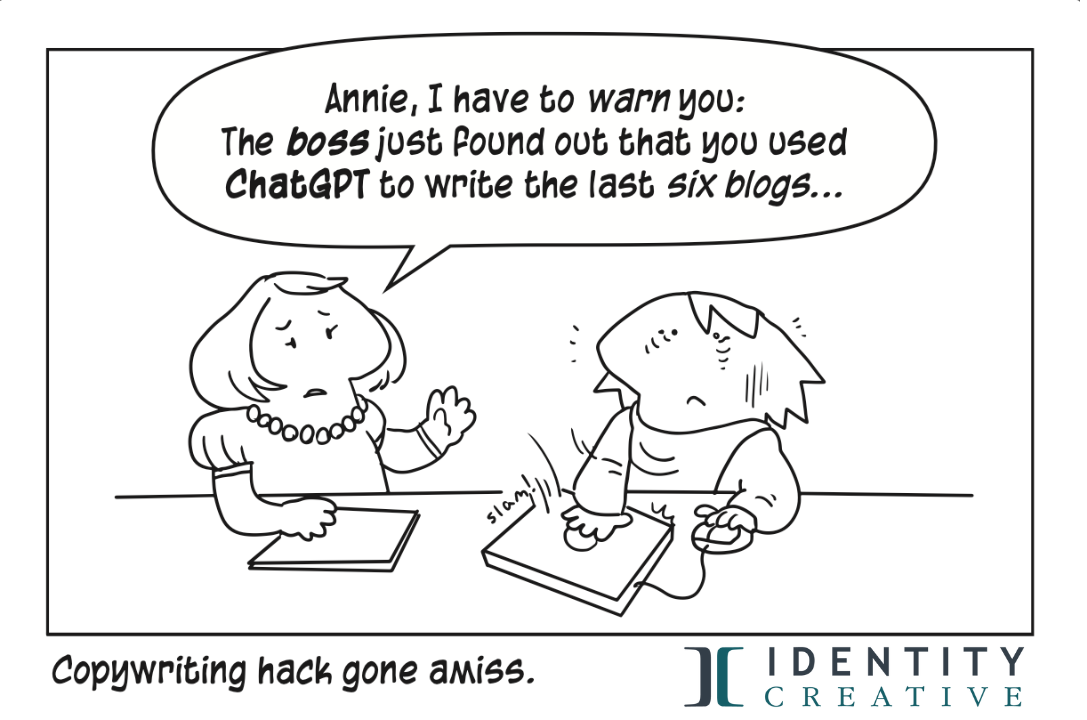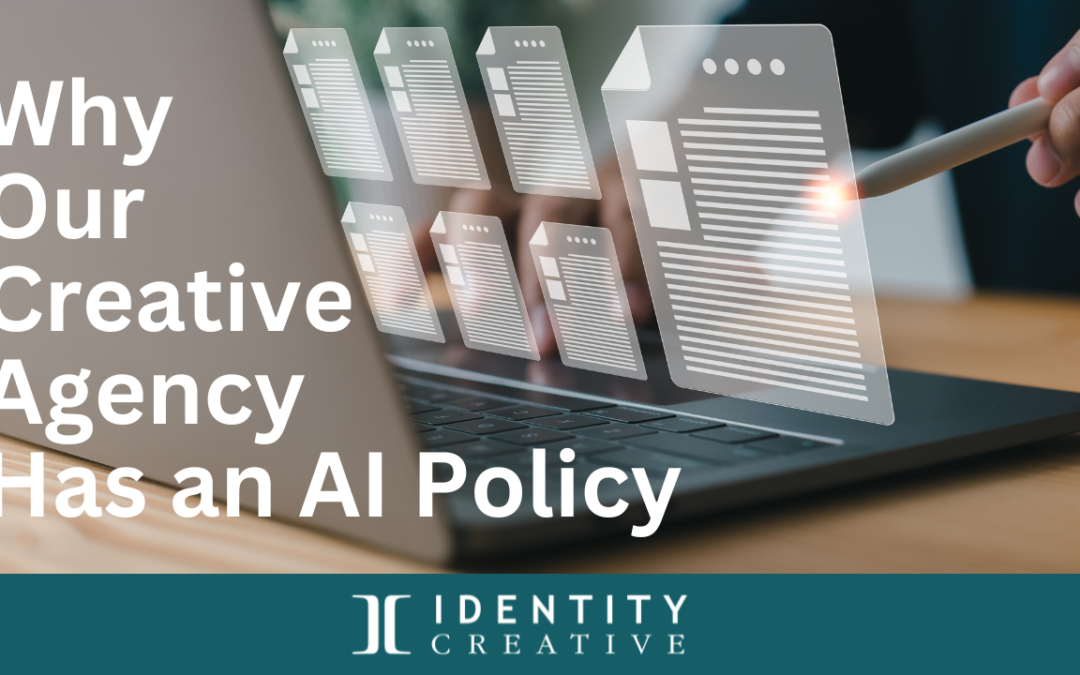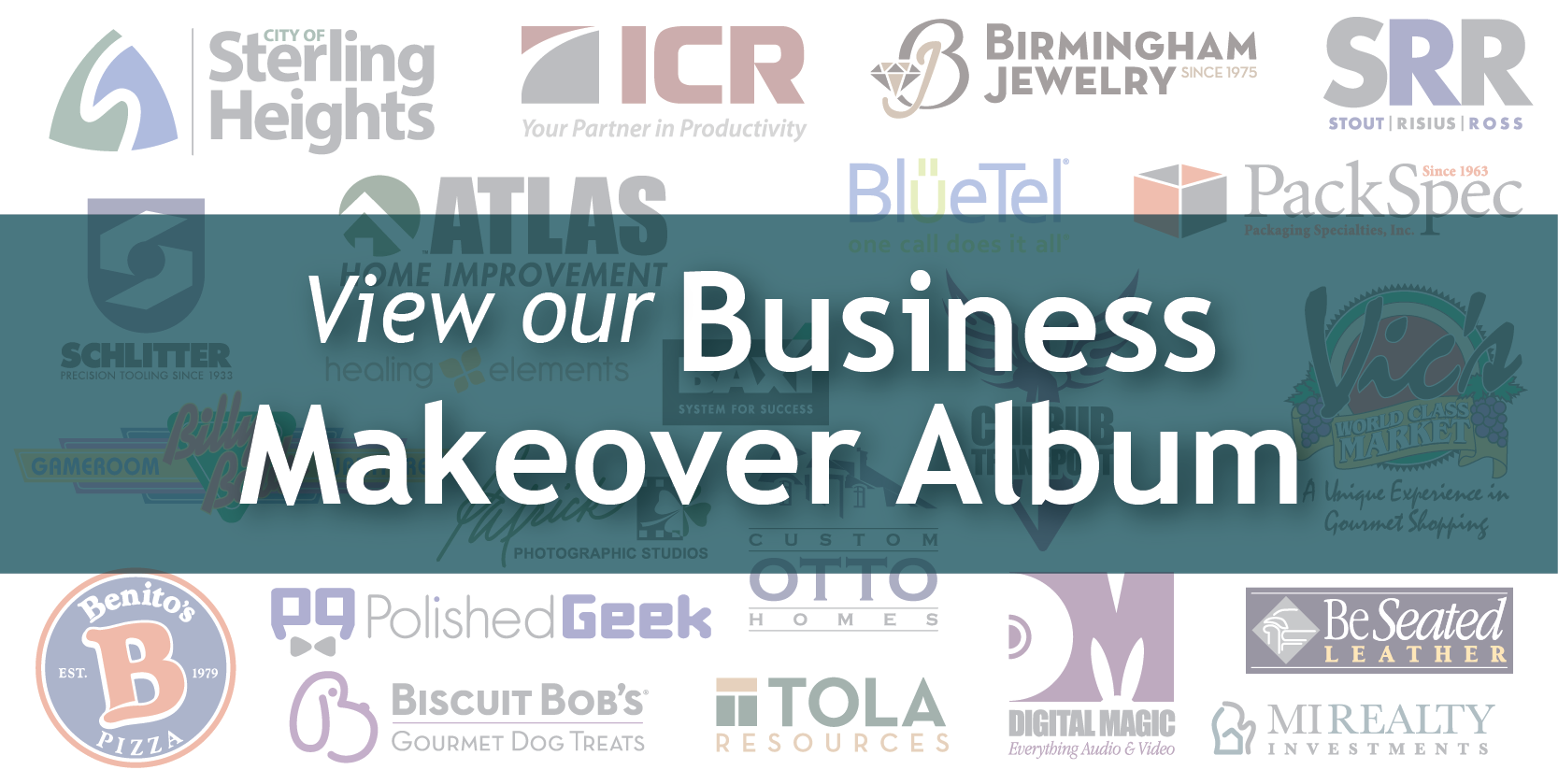A major shift is coming and it’s likely going to happen much sooner than we might imagine. Generative AI will be turning the marketing industry on its head. So, establishing an AI Policy for our creative agency makes sense.
We’ve all been using AI in our online experiences, but when ChatGPT was released on November 30, 2022, it seemed to open the floodgate of content creation to the common man. Very soon, if not already, all marketing software we currently use will be assisted–or solely dependent upon–generative AI.
Defining Terms: AI, GAI, LLM, and GPT
AI (Artificial Intelligence) is a general term for a coded program that calculates and responds as a human would. Its algorithms use data to discern patterns, translate languages, and solve problems.
GAI (Generative AI), as defined by Investopedia, is a “form of machine learning that can produce outputs in the same medium in which it is prompted (e.g., text-to-text) or in a different medium from the given prompt (e.g., text-to-image or image-to-video).”
From designing graphics to analyzing data, writing code, and providing customer service, GAI is quickly learning to deliver the content and solutions people want.
LLM (Large Language Model) is a kind of GAI, an AI framework trained to complete language-related tasks. As generative AI, these tools recognize language in context, understand meaning, and can generate new sequences of text.
GPT (Generative Pre-trained Transformer) was developed by OpenAI in 2018. OpenAI launched Chat GPT in November of 2022, and as a LLM, it continues to introduce upgraded versions.
AI Hallucinations: This term describes events and information that AI tools “make up.” It occurs when AI algorithms and generative-trained networks produce incorrect or unreal outputs. It’s a phenomenon because these hallucinations don’t exist in the data, nor does it align with any known pattern. Human oversight will continue to be a vital piece of GAI use.
What does GAI mean for creative agencies?
Agencies are feeling–or will be feeling very soon–significant pressure to incorporate GAI. Creative teams like ours are asking themselves, “How do we implement GAI to add efficiency without sacrificing human connection and weakening our creative muscle?”

If agencies use GAI well, we must select the optimal tools, know their limitations, be aware of any risks, and understand how to stack GAI tools for better results.
Identity Creative’s team has been exploring ways we will implement GAI.
At the AI for Agencies Summit, Paul Roetzer, Founder & CEO of Marketing AI Institute, and other speakers addressed many vital issues facing creative and marketing agencies. Roetzer kicked off the summit with an overview of how AI will significantly impact knowledge and customer service-based industries within the next year, listing industries that will soon need to adapt to an AI world or face becoming obsolete. (Think typewriter.)
Retail
E-commerce
Marketing agencies
Event businesses
Media companies
Law firms
Medical practices
Artists
Writers
Graphic designers
Financial services
Insurance
Software
Game and app dev
Real estate brokers
Consumer products
Hotels and restaurants
Manufacturers Distributors
Education
How will we use GAI in our business?
While we look for ways to improve efficiency with AI tools, we are cautious about implementing them to generate creative writing and design for three primary reasons:
1. Inappropriate reliance on AI can weaken human brain power and atrophy creative muscle.
2. The need to mitigate the risks of exposing proprietary data and intellectual property.
3. As GAI evolves, who will have copyright & trademark protection?
1. GAI and the Risk of Atrophying Human Creative Thinking
In collaboration with Harvard and three other universities, BCG, a global consulting firm, conducted a study on professional consultants using GAI. This study demonstrates a common denominator among many of us about using GAI.
The “creativity trap.” “Even when consultants used GPT-4 for tasks that showed the greatest performance gains, despite individual improvement, collective creativity scored lower.”
Alarmingly, “the homogenous output of GPT-4 reduced ‘diversity of thought’ by 41%.” – BCG Study
“Falling asleep at the wheel.” Fabrizio Dell’Acqua of Harvard used the term “falling asleep at the wheel” when people using AI tend to “switch off their brains” and “outsource their judgment to AI.”
If I’m guilty of leaning on GPS when driving a route I know, don’t I risk weakening my creative muscle by relying on GAI in my work? I’m not alone in my concern: 70% of the BCG consultants in the study worried that using GPT-4 would “stifle their creative abilities over time.”
2. GAI and Intellectual Property Protection
IP protection has been pretty straightforward in our work. We create original work and begin using it. We can get trademark protection ® © registering it or adding the TM symbol after a new product or service.
We’ve always been careful to give credit (e.g., cite an author’s work) or purchase an artist’s license if we use their work.
Our client agreements have the legal language to clarify who owns the created work. Leaning on IP attorneys and referring our clients to them has been pretty standard.
It appears, however, that GAI has opened a new can of intellectual property worms.
In her AI for Agencies Summit presentation, Sharon Torek, founder of Legal+Creative | Toerek Law, suggested that we’ll likely see more GAI companies place the responsibility for copyright infringement on the user.
Adobe, a well-respected and widely used software by artists and educators, includes “a new kind of tamper-evident metadata that can be applied to (GAI) assets at export or download. They increase transparency around the origins and history of the assets they are applied to.”
Adobe will attach and may publish Content Credentials (Adobe’s AI Beta Tool, Firefly, Terms and Agreement Content Credentials) for content created with generative AI features to let people know it was generated with AI.
Identifying the source of artwork is good for clients of creative agencies. People should know who has the rights to the creative work they’re paying for, and who could be liable for copyright infringement.
3. GAI Litigation Risk
Several guest speakers discussed AI-generated content and the potential legal liability. While I initially intended to learn how we can improve efficiency with our internal processes and deliver better results for our clients, I was not surprised to learn that there are and will be plenty of legal considerations as the use of AI tools increases.
Sharon Toerek covered the Wild West of GAI. She pointed out several risks and liabilities of using GAI tools. So much is open for new regulations and copyright law. Who owns the intellectual property of content created by GAI, and how are we protecting our clients’ intellectual property when using GAI tools?
While judicial and legislative action regarding GAI will likely be playing catchup, recently, I learned of several issues in the balance:
- Comedian Sarah Silverman and two other writers are suing OpenAI and Meta for copyright infringement.
- A federal judge in New York fined two attorneys for using ChatGPT because the program cited hallucinated cases that the attorneys used in their court brief.
- OpenAI is under investigation by the FTC for violating consumer protection laws.
Toerek and others have recommended that companies create AI policies for their team to establish guidelines and principles for the responsible and ethical use of artificial intelligence within their company.
Creating an AI Policy for Identity Creative
How we developed our AI Policy.
Jasper.ai has made their AI Policy template available for download. It helped me craft our first edition. As the GAI landscape evolves, we anticipate continually modifying the document. We’ve published a summary of our AI Policy here.
Already, it’s outdated, and it’s only a month old. Our team has decided that, at least for a while, we need to include a review of our GAI use in our monthly meetings.
In my research for how GAI will impact our industry, I kept notes on areas we need to stay alert to with GAI. I ended up with a list of ten, reinforcing the importance of creating a GAI policy for our team.
10 Reasons Why a Creative Agency Needs to Implement an AI Policy:
- Ethical Considerations: To ensure that AI tools are used in a manner that aligns with our ethical standards and values of original work, privacy, and transparency.
- Data Privacy and Security: To protect sensitive client and user data from open-source AI software.
- Accountability: To ensure that the outputs of AI tools are accurate and that our team is on the same page with using AI systems.
- Legal Compliance: To adhere to existing and emerging laws and regulations related to AI use in the creative industry.
- Bias and Fairness: To recognize and mitigate biases in AI algorithms to ensure equitable outputs.
- Innovation and Research: To encourage responsible experimentation with AI technologies to foster innovation.
- Quality Assurance: To establish clear guidelines for validating and verifying AI outputs and hold employees accountable for maintaining quality standards.
- Cultural Adaptability: To foster a culture of innovation and the ability to adapt to emerging AI technologies. Seek to stay informed about the latest advancements in AI as a team and incorporate responsible AI practices into our work.
- Risk Mitigation: To identify and mitigate potential risks associated with AI implementation.
- Stay on top of an evolving industry!
– Regularly review and update our policy to address emerging ethical concerns in AI.
– Identify appropriate use cases and reliable, reputable tools
– Establish a process for reviewing and approving new AI projects
– Regularly solicit feedback from users and clients to identify areas of improvement.
Will GAI replace the need for creative branding and marketing agencies when companies can access GAI?
It’s a very real question. At least for now, AI tools need humans to use them. And as mentioned above, there are risks with its use. AI Hallucinations: This term describes events and information that AI tools “make up.”
I was tempted to write this post with ChatGPT, but I didn’t. Writing helps me give deeper thought to issues, whether journaling or writing a blog. Even if no one reads my articles, I want them to be from me, not a machine.
Generative AI One Year From Now
At this writing, it has been about one year since Open AI released Chat GPT, and the rumbles of a significant impact are beginning to be felt. Where will we be a year from now?
For some, it’s exciting and opens doors of opportunity, cost savings, and expanded outputs. For others, it’s multiplied fears of obliterating their careers and potentially taking humankind to unhuman places where there will be no return.





